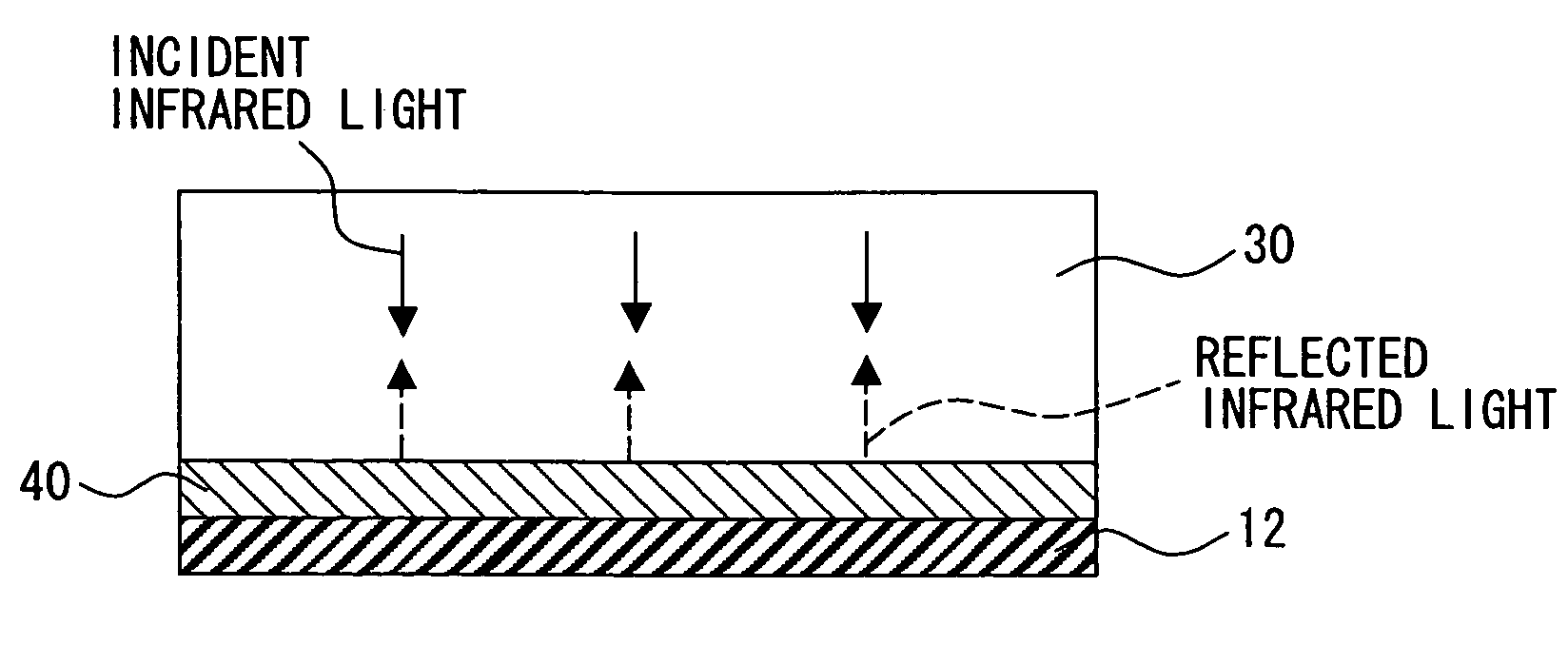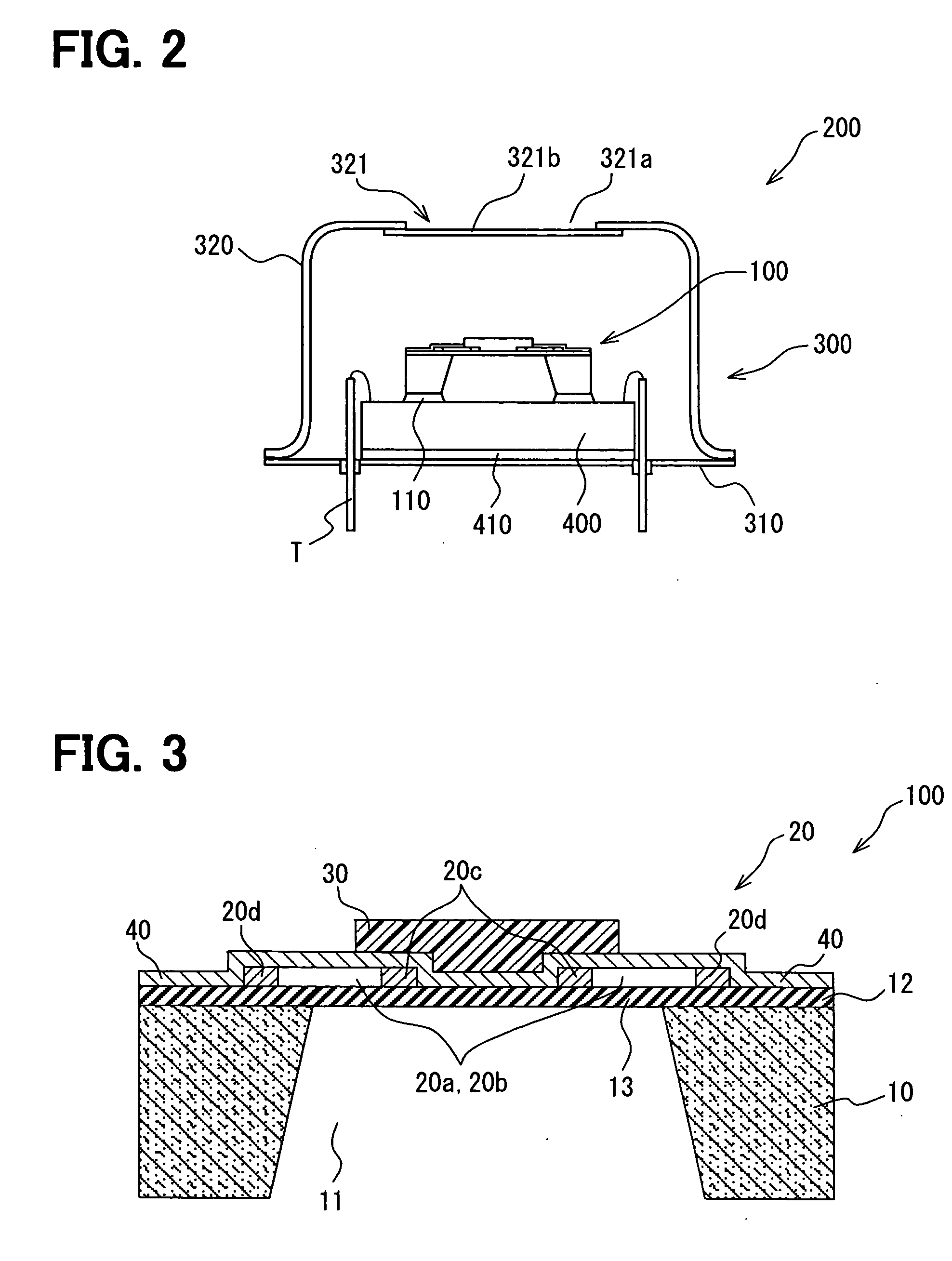Infrared sensor
a technology of infrared sensor and infrared light, which is applied in the field of infrared sensors, can solve the problems of insufficient coverage of metal layers, degraded sensitivity of sensors to infrared light, and decreased temperature difference between cold junctions and hot junctions, so as to improve the sensitivity of sensors
- Summary
- Abstract
- Description
- Claims
- Application Information
AI Technical Summary
Benefits of technology
Problems solved by technology
Method used
Image
Examples
first embodiment
[0019]FIGS. 1A, 1B and 1C show schematically the construction of a thermopile-type infrared sensor 100 according to a first embodiment. As shown in FIG. 1A, the infrared sensor 100 mainly includes a substrate 10, a sensing element 20, an infrared light absorption film 30, and an infrared light reflection coating 40. The substrate 10 is a semiconductor substrate formed of, for example, silicon, and has a cavity 11 that is formed by wet etching from the rear surface of the substrate 10. In this embodiment, the cavity 11 opens at the rear surface to have a certain rectangular area, and the area of the opening is tapered, as shown, toward the upper surface side of the substrate 10. The rectangular opening at the upper surface of the substrate 10 is indicated by a dashed broken line in FIG. 1B and corresponds to a formation area of a membrane 13 as a thin part. The region surrounding the rectangular area indicated by the dashed broken line in FIG. 1B is a thick part where bonding pads an...
second embodiment
[0038]FIG. 3 shows the schematic construction of a thermopile-type infrared sensor 100 according to the second embodiment. The infrared sensor 100 according to the second embodiment has many parts common to the infrared sensor of the first embodiment. Therefore, the same reference numerals are given to corresponding or similar parts, and a detailed description of the common parts is omitted from the following description, and different parts will be mainly described.
[0039] In the first embodiment, the infrared light reflection coating 40 is located only at the region surrounding the infrared light absorption film 30. However, in this (second) embodiment, an infrared light reflection coating 40 is located not only at the surrounding region but also a region underlying an infrared light absorption film 30. That is, the infrared light reflection coating 40 covers entirely the upper surface of the substrate 10 and thereby covers the entire thermopile pattern, including hot junctions 20...
third embodiment
[0041]FIG. 5 shows the schematic construction of a thermopile-type infrared sensor 100 according to the third embodiment. The infrared sensor 100 according to the second embodiment has many parts common to the infrared sensor of the first and second embodiments. Therefore, the same reference numerals are given to corresponding or similar parts, and a detailed description of the common parts is omitted from the following description, and different parts will be mainly described.
[0042] In the second embodiment, the infrared light reflection coating 40 entirely covers the sensing element 20 with a single layer structure. However, in this (third) embodiment, an infrared light reflection coating 40 has an overlying part and an underlying part as shown in FIG. 5. That is, the overlying part of the infrared light reflection coating 40 surrounds the infrared light absorption film 30 and is laid over the cold junctions 20d like the first embodiment. The underlying part of the infrared light...
PUM
 Login to View More
Login to View More Abstract
Description
Claims
Application Information
 Login to View More
Login to View More - R&D
- Intellectual Property
- Life Sciences
- Materials
- Tech Scout
- Unparalleled Data Quality
- Higher Quality Content
- 60% Fewer Hallucinations
Browse by: Latest US Patents, China's latest patents, Technical Efficacy Thesaurus, Application Domain, Technology Topic, Popular Technical Reports.
© 2025 PatSnap. All rights reserved.Legal|Privacy policy|Modern Slavery Act Transparency Statement|Sitemap|About US| Contact US: help@patsnap.com



